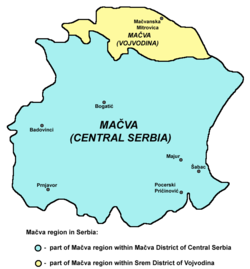Mačva
Mačva
Мачва | |
|---|---|
Geographical and historical region of Serbia | |
 Map of the Mačva region | |
| Country | |
| Largest city | Šabac |
| Population | |
| • Total | 150,000 |
Mačva (
Name
The region is named after a town of Mačva, which existed in the Medieval Ages near the river Sava. In the past, the region was also known as Lower Srem, while the neighbouring region on the northern bank of the river Sava (present-day Srem) was known as Upper Srem.
In Serbian Cyrillic, the region is known as Мачва, in Serbian Latin, Bosnian and Croatian as Mačva, in Hungarian as Macsó or Macsóság, in Turkish as Maçva, and in German as Matschva.
History
Throughout history, the region of Mačva has successively been a part of the
Mačva was inhabited since the
Roman rule lasted until the 5th century, and the region was conquered by the Sarmatians, Huns, Goths, Gepids, Lombards and Avars. In the 6th century, Slavic tribes settled in the region.




The region was then included into
In the 13th century, the region was included into the
During the Hungarian administration the region was ruled by several powerful
).Between 1282 and 1316 the Serb King
At first, Stefan Dragutin was a vassal of the Hungarian king, but since the central power in the Kingdom of Hungary collapsed, both, Stefan Dragutin and Ugrin Csák were de facto independent rulers. Stephen Dragutin died in 1316, and was succeeded by his son, King Vladislaus II (1316–1324).[2] Vladislaus II was defeated by the king of Serbia, Stefan Dečanski, in 1324, and after this, Mačva became a subject of dispute between the Kingdom of Serbia and the Kingdom of Hungary.
In the 14th century, the bans of the
In the 15th century, Mačva was part of
During World War I, the
Geography
Mačva is located in the southern edge of
Inhabited places


List of largest inhabited places in Mačva (with population figures):
- Šabac (55,163)
- Bogatić (7,350)
- Majur(6,854)
- Pocerski Pričinović (5,992)
- Badovinci (5,406)
- Prnjavor(4,464)
- Mačvanska Mitrovica (3,896)
Note: Mačvanska Mitrovica is geographically located in Mačva, but it is part of
Education
Several teachers' associations exist in Mačva.[5]
Famous people from Mačva
- Rus'prince, first Duke of Mačva (after 1248–1262)
- Stefan Dragutin, king of Lower Srem (Mačva) between 1282 and 1316.
- Stefan Vladislav II, king of Lower Srem (1316–1325).
- Uroš Drmanović, oberknez of "Mačvanska knežina" in 1788.
- Stojan Čupić (1765–1815), also known as "Zmaj od Noćaja", was a Serbian voivod in the First Serbian Uprising.
- Milorad Ruvidić (1863 - 1914), Serbian architect.
- Laza Lazarević (1851–1891), Serbian writer and psychiatrist.
- Janko Veselinović (1862–1905), Serbian literate.
- Bora Simić - Joja (born in 1929), poet.
- Milić Stanković (1934–2000), a controversial painter who became known as Milić od Mačve(meaning "Milić of Mačva").
- Dušan Kovačević (born in 1948), literate, dramaturgist.
- Dragan Martinović (born in 1957), painter.
- Nenad Stanković (born in 1965), painter.
- Miloš Blagojević (born in 1989), sculptor.
See also
- Mačva District
- Banate of Mačva
References
- ^ "Map". roman-glory.com. Retrieved 10 September 2023.
- ^ Krstić 2016, p. 33–51.
- ^ a b Istorijski atlas, Geokarta, Beograd, 1999.
- ^ "Ivana Carevic, Velimir Jovanovic, STRATIGRAPHIC-STRUCTURAL CHARACTERISTICS OF MAČVA BASIN, UDC 911.2:551.7(497.11), pg. 1" (PDF). Archived from the original (PDF) on 30 August 2016.
- ^ http://www.macvanski.page.tl/ English Language Teachers` Association, Mačva county
Sources
- Bárány, Attila (2020). "The Relations of King Emeric and Andrew II of Hungary with the Balkan States". Stefan the First-Crowned and His Time. Belgrade: Institute of History. pp. 213–249. ISBN 9788677431396.
- ISBN 9782825119587.
- ISBN 9781405142915.
- Engel, Pál (2001). The Realm of St. Stephen: A History of Medieval Hungary, 895-1526. London & New York: I.B.Tauris. ISBN 9781850439776.
- ISBN 0472081497.
- ISBN 0472082604.
- Fodor, Pál; Dávid, Géza, eds. (2000). Ottomans, Hungarians, and Habsburgs in Central Europe: The Military Confines in the Era of Ottoman Conquest. Leiden: BRILL. ISBN 9004119078.
- Font, Márta (2020). "Rostislav, Dominus de Macho". Stefan the First-Crowned and His Time. Belgrade: Institute of History. pp. 309–326. ISBN 9788677431396.
- Isailović, Neven (2016). "Living by the Border: South Slavic Marcher Lords in the Late Medieval Balkans (13th–15th Centuries)". Banatica. 26 (2): 105–117.
- Ivanović, Miloš; Isailović, Neven (2015). "The Danube in Serbian-Hungarian Relations in the 14th and 15th Centuries". Tibiscvm: Istorie–Arheologie. 5: 377–393.
- Jireček, Constantin (1911). Geschichte der Serben. Vol. 1. Gotha: Perthes.
- Jireček, Constantin (1918). Geschichte der Serben. Vol. 2. Gotha: Perthes.
- Krstić, Aleksandar R. (2016). "The Rival and the Vassal of Charles Robert of Anjou: King Vladislav II Nemanjić". Banatica. 26 (2): 33–51.
- McDaniel, Gordon L. (1984). "On Hungarian-Serbian Relations in the Thirteenth Century: John Angelos and Queen Jelena" (PDF). Ungarn-Jahrbuch. 12 (1982-1983): München, 1984: 43–50.
- Pálosfalvi, Tamás (2018). From Nicopolis to Mohács: A History of Ottoman-Hungarian Warfare, 1389-1526. Leiden: BRILL. ISBN 9789004375659.
- Vasin, Dejana (2019). "Natural Conditions as a Factor of Urbanization of the Lower Posavina in the Middle Ages". Istraživanja: Journal of Historical Researches. 30 (30): 45–68. .

